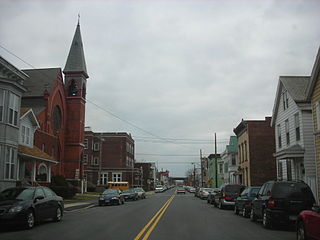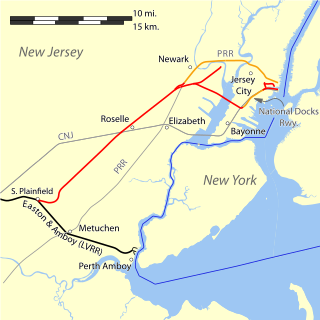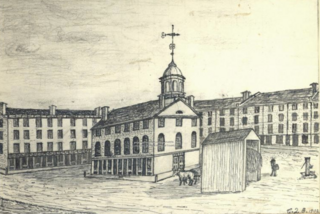
Murray Hill Hotel was located on Murray Isle in the Thousand Islands region of the St. Lawrence River in the U.S. state of New York. Built in 1895, and closed in 1915, it could accommodate 500 guests.

Murray Hill Hotel was located on Murray Isle in the Thousand Islands region of the St. Lawrence River in the U.S. state of New York. Built in 1895, and closed in 1915, it could accommodate 500 guests.
The hotel was initially owned by Amasa Corbin Jr. of Gouverneur and Capt. James “Jack” Taylor. A seasonal hotel, it was open from May to September for 20 years. [1] Although the hotel had modern amenities, the various lessees led to a failing enterprise. In 1912, it was sold to the Republic Trust Company of Dallas, Texas, but it closed three years later, and was demolished in 1942. [2]

The hotel was constructed in 1895 at a cost of US$100,000. It measured 300 feet (91 m) in length and four stories in height. The wraparound porch measured 520 by 18 feet (158.5 m × 5.5 m). [2] It was equipped with electric lights and electric calls, billiard parlors, bowling alleys, elevator and fireplaces. It had what was advertised at one time as the largest dining-room, largest parlor, largest office, largest ladies' billiard-room, and longest and widest piazza of any hotel of the Adirondacks or Thousand Islands. Rates were $3.00 and $4.00 per day. [3]
The hotel was situated on Eel Bay, and advertised fishing opportunities on the St. Lawrence River. Boating and sailing were also available. [4]

The Thousand Islands constitute a North American archipelago of 1,864 islands that straddles the Canada–US border in the Saint Lawrence River as it emerges from the northeast corner of Lake Ontario. They stretch for about 50 miles (80 km) downstream from Kingston, Ontario. The Canadian islands are in the province of Ontario and the U.S. islands in the state of New York.

Green Island is a coterminous town-village in Albany County, New York, United States, some 8 miles (13 km) north of Albany. Green Island is one of only five such town-village amalgamations in New York. The population was 2,934 at the 2020 census, and the ZIP code is 12183. While the town of Green Island was once an island, it was connected to the mainland on the west side of the Hudson River in the 1960s.

The New York Central Railroad was a railroad primarily operating in the Great Lakes and Mid-Atlantic regions of the United States. The railroad primarily connected greater New York and Boston in the east with Chicago and St. Louis in the Midwest, along with the intermediate cities of Albany, Buffalo, Cleveland, Cincinnati, Detroit, Rochester and Syracuse. New York Central was headquartered in New York City's New York Central Building, adjacent to its largest station, Grand Central Terminal.

Harlem–125th Street station is a commuter rail stop serving the Metro-North Railroad's Hudson, Harlem, and New Haven Lines. It is located at East 125th Street and Park Avenue in East Harlem, Manhattan, New York City. The station also serves as an important transfer point between the Metro-North trains and the New York City Subway's IRT Lexington Avenue Line for access to the Upper East Side of Manhattan. It is the only station besides Grand Central Terminal that serves all three lines east of the Hudson River. Trains leave for Grand Central Terminal, as well as to the Bronx and the northern suburbs, regularly.
The New York and Harlem Railroad was one of the first railroads in the United States, and was the world's first street railway. Designed by John Stephenson, it was opened in stages between 1832 and 1852 between Lower Manhattan Island to and beyond Harlem. Horses initially pulled railway carriages, followed by a conversion to steam engines, then on to battery-powered Julien electric traction cars. In 1907, the then leaseholders of the line, New York City Railway, a streetcar operator, went into receivership. Following a further receivership in 1932, the New York Railways Corporation converted the line to bus operation. The Murray Hill Tunnel now carries a lane of road traffic, but not the buses.

The Steinway Tunnel is a pair of tubes carrying the IRT Flushing Line of the New York City Subway under the East River between 42nd Street in Manhattan and 51st Avenue in Long Island City, Queens, in New York City. It was originally designed and built as an interurban trolley tunnel, with stations near the current Hunters Point Avenue and Grand Central stations.

The Delaware and Hudson Canal was the first venture of the Delaware and Hudson Canal Company, which would later build the Delaware and Hudson Railway. Between 1828 and 1899, the canal's barges carried anthracite coal from the mines of northeastern Pennsylvania to the Hudson River and thence to market in New York City.
The New York and Ottawa Railway was a railway connecting Tupper Lake in northeastern New York to Ottawa, Ontario, via Ramsayville, Russell, Embrun, Finch and Cornwall. It became part of the New York Central Railroad system in 1913, although it was under the larger company's possession since the end of 1904. It had started out as the Northern Adirondack Railroad and evolved into the Northern New York Railroad, the New York and Ottawa Railroad, and was last known as the New York and Ottawa Railway before being merged into the New York Central and Hudson River Railroad. Other lines that were a part of this route are described below.

The Walkway over the Hudson is a steel cantilever bridge spanning the Hudson River between Poughkeepsie, New York, on the east bank and Highland, New York, on the west bank. Built as a double track railroad bridge, it was completed on January 1, 1889, and formed part of the Maybrook Railroad Line of the New York, New Haven and Hartford Railroad.

The Spuyten Duyvil Bridge is a railroad swing bridge that spans the Spuyten Duyvil Creek between Manhattan and the Bronx, in New York City. The bridge is located at the northern tip of Manhattan where the Spuyten Duyvil Creek meets the Hudson River, approximately 1,000 feet (300 m) to the west of the Henry Hudson Bridge.

The Park Avenue main line, which consists of the Park Avenue Tunnel and the Park Avenue Viaduct, is a railroad line in the New York City borough of Manhattan, running entirely along Park Avenue. The line carries four tracks of the Metro-North Railroad as a tunnel from Grand Central Terminal at 42nd Street to a portal at 97th Street, where it rises to a viaduct north of 99th Street and continues over the Harlem River into the Bronx over the Park Avenue Bridge. During rush hours, Metro-North uses three of the four tracks in the peak direction.

The Lehigh Valley Terminal Railway was a Lehigh Valley Railroad company organized in 1891 through the consolidation of the companies that formed the Lehigh Valley's route from South Plainfield through Newark to Jersey City via its bridge across Newark Bay. Until 1895, when the Greenville and Hudson Railway was constructed, the Lehigh Valley depended on the National Docks Railway to reach the Hudson River terminal.

The Northwestern Elevated Railroad was the last of the privately constructed rapid transit lines to be built in Chicago. The line ran from the Loop in downtown Chicago north to Wilson Avenue in Chicago's Uptown neighborhood with a branch to Ravenswood and Albany Park that left the main line at Clark Street. The Ravenswood line is now operated as the Brown Line, while the Main Line is used by the Purple and Red Lines.
The Parish of Good Shepherd and St. Joseph is a parish under the authority of the Roman Catholic Archdiocese of New York, located in Rhinebeck, Dutchess County, New York. The church address is Good Shepherd Church, 3 Mulberry Street, Rhinebeck, New York 12572

The Briarcliff Lodge was a luxury resort in the village of Briarcliff Manor, New York. It was a notable example of Tudor Revival architecture, and was one of the largest wooden structures in the United States. It was also the first hotel in Westchester County. Walter William Law had it built on his estate, and the Law family owned it until 1937. When the lodge opened in 1902, it was one of the largest resort hotels in the world. The lodge hosted presidents, royalty, and celebrities, and was the scene of numerous memorable occasions for visitors and local residents who attended weddings, receptions, and dances in the ballroom and dining room. For a long time, the lodge was situated among other businesses of Walter Law, including the Briarcliff Farms and Briarcliff Table Water Company.

Murray Hill Hotel was a hotel situated at 112 Park Avenue in Murray Hill, Manhattan, New York City. Built in 1884, with 600 rooms and two courtyards, it was demolished in 1947. It was part of the Bowman-Biltmore Hotels chain.

The Grand View Beach Railway was a scenic electric street railway along the shore of Lake Ontario from the village of Ontario Beach, a suburb of Rochester, to Manitou Beach.

The United States Hotel was a hotel in Portland, Maine. At the time of its closure, in 1900, it was one of the oldest hotels in the city, having been in business for 97 years. The hotel stood on Federal Street, behind Market House, in what was then known as Haymarket Square. Built in 1803 as the Washington Hall Hotel, it was later renamed the Cumberland Hotel. It was renamed again, around 1829, to the Portland House, then the Cumberland House in 1835.